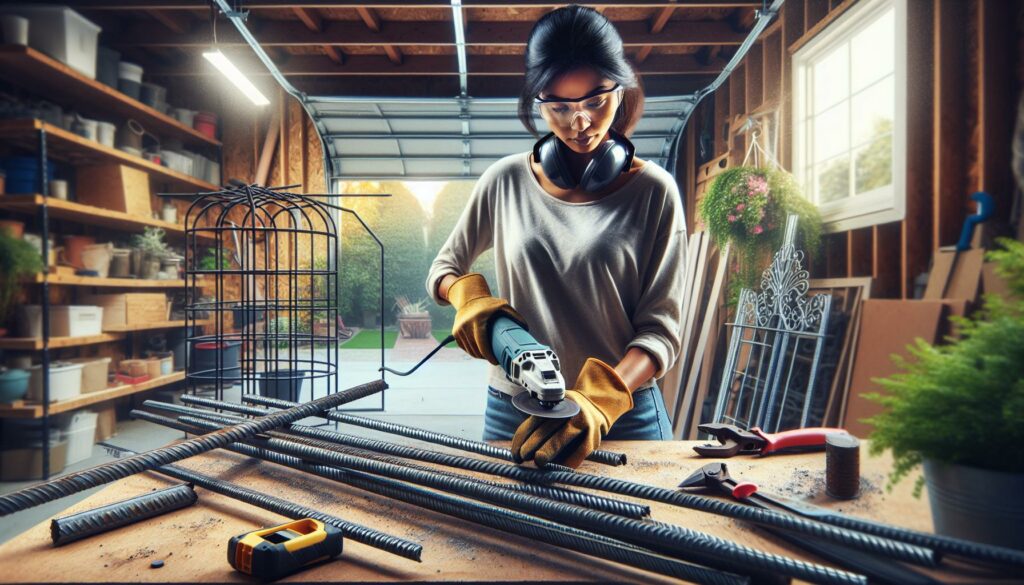If you’re looking for a way to elevate your home projects, DIY rebar creations might just be the answer. Rebar isn’t just for construction sites; it’s a versatile material that can add strength and style to your DIY endeavors. From garden trellises to furniture pieces, the possibilities are endless, and the results can be stunning.
Key Takeaways
- Versatility of Rebar: DIY rebar projects can create both functional and decorative items, such as garden trellises, furniture, and unique art pieces.
- Essential Tools and Materials: Key tools like an angle grinder, rebar cutter, and protective gear, along with the right rebar specifications, are crucial for successful projects.
- Safety First: Prioritize safety by wearing protective gear, using the appropriate tools, organizing your workspace, and being aware of your surroundings while working.
- Creative Expression: Rebar allows for creativity in design, enabling DIY enthusiasts to customize projects to match their individual style and enhance their living spaces.
- Maintenance and Longevity: Regular inspections, proper surface treatment, and appropriate storage are vital for extending the lifespan of rebar projects, ensuring durability and performance.
DIY Rebar Projects
DIY rebar projects offer a blend of utility and creativity, making them suitable for various applications around the home. Rebar, known for its strength and durability, can be repurposed into functional and decorative items. Popular projects include garden trellises, which provide support for climbing plants, and furniture pieces like chairs and tables that showcase an industrial aesthetic.
I’ve noticed an increase in using rebar for decorative elements, such as fire pits and modern sculptures. These projects not only serve a practical purpose but also enhance outdoor spaces. Additionally, rebar can be transformed into planters, fence accents, and even lighting fixtures, allowing for unique personalization.
The flexibility of rebar makes it suitable for indoor and outdoor uses, adapting well to different designs. Safety is important, so using the right tools, such as an angle grinder to cut rebar, is critical to ensuring a successful project. Exploring the myriad of DIY rebar projects sparks ingenuity and encourages creative expression.
I find that experimenting with rebar opens up endless possibilities. Each project showcases individual style while providing strength and stability. With an array of sizes and shapes, rebar can fit nearly any design vision, making it a valuable material for DIY enthusiasts.
Essential Tools and Materials
I focus on having the right tools and materials to ensure successful DIY rebar projects. Understanding the essentials helps streamline the process and enhances the final result.
Choosing the Right Rebar
I choose rebar based on diameter, typically ranging from #3 (3/8 inch) to #8 (1 inch), depending on the project requirements. Structural strength dictates selecting the appropriate grade, such as Grade 40 or Grade 60, which indicates yield strength measured in thousands of pounds per square inch. Corrosion resistance plays a key role as well; using epoxy-coated or galvanized rebar can prolong the lifespan of outdoor projects. Additionally, I consider length options that best fit the intended designs, allowing for fewer joints and a cleaner look.
Required Tools for DIY Projects
I gather essential tools to tackle DIY rebar projects effectively, ensuring safety and accuracy throughout the process. These include:
- Angle Grinder: I use an angle grinder for cutting rebar to desired lengths. The right blade makes clean cuts with minimal effort.
- Rebar Cutter: A rebar cutter provides a safer and easier method for cutting through heavy-duty rebar.
- Pliers: I keep pliers handy for bending rebar, as they offer better control and leverage for shaping.
- Protective Gear: I wear safety goggles, gloves, and a dust mask to safeguard against flying debris and flying fragments during cutting and bending.
- Measuring Tape: A measuring tape helps with precise measurements to ensure accuracy in every project.
- Level: A level ensures that my structures remain even, preventing potential issues in stability and aesthetics.
By selecting the right materials and tools, I create stunning and durable pieces that showcase my creativity and craftsmanship.
Popular DIY Rebar Projects
Rebar projects enhance spaces with both functionality and aesthetic appeal. These popular DIY ideas demonstrate the versatility of rebar, suitable for a variety of settings and purposes.
Rebar Garden Trellis
Rebar garden trellises support climbing plants beautifully. I can create a durable and attractive structure by using vertical stakes connected with horizontal rebar. This design allows for optimal sunlight exposure and airflow. For added creativity, I can incorporate multiple levels or geometric shapes, which enhances visual interest. The strength of rebar ensures that the trellis withstands harsh weather conditions, making it a long-lasting garden feature.
Rebar Furniture Ideas
Rebar furniture blends industrial style with modern design. I can build items like coffee tables, benches, or shelves by combining rebar frames with wooden or glass surfaces. Thicker rebar provides stability, while thinner bars add elegance. For a unique touch, I can paint the rebar or leave it in its natural finish, which creates a stunning visual contrast. Adding cushions to seating can combine comfort with the industrial look, making it suitable for both indoor and outdoor spaces.
Rebar Art and Sculptures
Rebar lends itself well to artistic creations, ranging from abstract sculptures to functional art pieces. I can bend and weld rebar into intricate designs that serve as conversation starters in gardens or living rooms. By incorporating other materials, like wood or glass, I can enhance the artistic expression. Rebar’s strength allows for larger installations, providing stability without compromising aesthetics. This opportunity for creative exploration showcases my style while adding character to any environment.
Safety Tips for Working with Rebar
Using rebar in DIY projects requires attention to safety. Here are essential safety tips to ensure a safe working environment:
- Wear Protective Gear
Always wear safety goggles to protect your eyes from flying debris. Use gloves to avoid cuts and scrapes from sharp edges. A dust mask prevents inhaling dust particles while cutting. Steel-toed boots protect your feet from heavy falling objects. - Use Proper Tools
Choose the right tools for each task. An angle grinder efficiently cuts rebar. A rebar cutter simplifies the process and reduces the risk of injury. Ensure tools are in good condition before use. - Secure Your Work Area
Keep your workspace organized and free from clutter. Clear the area of any unnecessary items to prevent tripping hazards. Ensure the rebar is properly secured using clamps or vises to avoid movement during cutting or bending. - Be Aware of Surroundings
Consider your surroundings while working. Ensure no one is in close proximity when using power tools. Be mindful of overhead structures or power lines when working outdoors to avoid accidents. - Handle with Care
Move rebar carefully, especially long pieces. Use proper lifting techniques to prevent strain or injury. If lifting heavy sections, ask for assistance to avoid accidents. - Follow Manufacturer Instructions
Always adhere to the manufacturer’s guidelines for tools and materials. This includes understanding how to operate tools safely and the best practices for working with rebar. - Keep First Aid Supplies Accessible
Maintain a well-stocked first aid kit nearby. In case of minor injuries, quick access to supplies like bandages and antiseptic can be essential. - Know Emergency Procedures
Familiarize yourself with emergency procedures in case of severe injuries. Keep emergency contact numbers handy and ensure someone nearby knows how to administer first aid.
By following these safety tips, I can work confidently on my DIY rebar projects while minimizing risks and ensuring a successful outcome.
Maintenance and Longevity of Rebar Projects
Maintaining the longevity of rebar projects involves several key practices. I ensure proper surface treatment to enhance corrosion resistance. Applying a suitable sealant or paint can protect exposed rebar from moisture and rust, significantly extending its lifespan.
Regular inspections are vital for identifying signs of wear or damage. I check welds, joints, and any connections for stress or deterioration. Addressing issues promptly prevents further degradation and maintains structural integrity.
Cleaning makes a substantial difference in the durability of rebar projects. I remove dirt, debris, and rust using a wire brush or sandpaper. For projects exposed to harsh weather conditions, I pay closer attention to any buildup that may lead to deterioration.
Proper storage of rebar materials contributes to their longevity. When not in use, I store rebar in a dry, shaded area to minimize rust and damage. Avoiding contact with wet ground surfaces stops moisture accumulation.
Adapting to local climate conditions enhances the resilience of my rebar projects. In environments with high humidity or salinity, I select high-quality materials resistant to corrosion. Taking these factors into account makes a significant impact on the project’s durability.
Finally, I document maintenance activities and inspections for future reference. Keeping a log of any repairs or treatments ensures that I stay proactive in preserving my DIY rebar projects.


